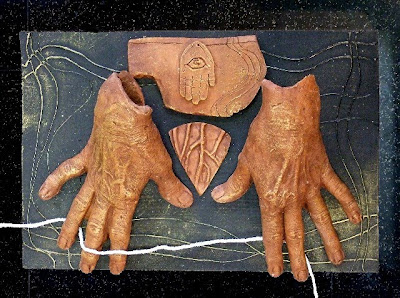
if we saw with a webbed vision?
Catherine Keller, "From a Broken Web"
 "What is the new mythology to be, the mythology
"What is the new mythology to be, the mythologyof this unified earth as of one harmonious being?"
Joseph Campbell
All arts, like dreams, have different layers of meaning. As I worked, the "story" of this progression of hands became clearer to me. It is dedicated to the ongoing collaboration of the community here at the Luce Center. For me, it's also a new “telling” of my exploration of the story of the Spider Woman. Spider Woman is the weaver deity found throughout Native American mythology.

It’s said that all stories originate in the mind of Spider Woman.
The "Hand and Eye" is the hand of the Divine, from which all inspirations come. This piece is about the evolution of an idea, and so the first pair of hands, "The Weaver", belong to Cathy Kapikian, who retired this year from the arts program she founded. Without her vision the Luce Center would not exist.

The third panel, "The Seed Planter" seemed a fitting progression: all inceptions need visionary collaborators, people who find the means to "ground it into the soil."
I made tiles based on stories told me by the people who volunteered to have their hands cast. For example, Mr.Tortorici told me that his family came from a village famous for growing olives, and so I made him an olive branch. Ms. Oden, who is the Dean, told me she missed the wild storms of her homeland, Oklahoma....and so I had fun inscribing a storm scene on her panel.
 Dr. Hopkins is an archaeologist, thus his panel had pottery shards on it.
Dr. Hopkins is an archaeologist, thus his panel had pottery shards on it.
Mr. Soulen is a banjo player, and also a bee keeper,
 which is why I put a flower on the neck of his instrument.
which is why I put a flower on the neck of his instrument.Doug Purnell is a painter, the other resident artist with me this term. Olaf, who is from Iceland, makes her art from fabric and is a gifted seamstress. And Amy Gray brought the Gardener's graceful hands, offering the metaphor of the flowering of an idea and co-creation.
 Finally, I included the hands of Colleen Nelson, who has been a community activist and advocate all of her life.
Finally, I included the hands of Colleen Nelson, who has been a community activist and advocate all of her life.Next to last, those of Deborah Sokolove, the new Director of the Luce Center. Deborah says of her own artwork that they are "prayers made visible", and so I titled her panel (she made her own tile) the "Iconographer". Because that is what an Icon, to me, is.
 ( I have to add that Deborah was once a professional weaver; and the backgrounds to all of her paintings include a woven motif. A nice continuity of "webbed vision" here!)
( I have to add that Deborah was once a professional weaver; and the backgrounds to all of her paintings include a woven motif. A nice continuity of "webbed vision" here!)
"Planetary consciousness is knowing as well as feeling the vital interdependence and essential oneness of humankind and the conscious adoption of the ethic and the ethos that this entails. Its evolution is the basic survival on this planet."
Ervin Lazlo, Macroshift
Here is the structure:
“The Divine Hand”
“The Weaver” - “The Seed Planter”
(because inceptions need visionary collaborators, people who can "ground it into the soil.")
“The Orcharder” “The Archaeologist”
One to tend growing trees, to insure they will be fruitful. And nothing can be woven true without understanding the past.
“The Artist” - “The Administrator”
(Art brings aesthetics. And administrators weather storms.)
“The Musician” - “The Gardener”
Music brings harmony and sweetness, bees and gardens collaborate to flower.
“The Advocate” - “The Seamstress”
A seamstress is one who fine tunes the fabric, mending tears, while activists bring justice, attending to threads that are broken.
“The Iconographer” - “Hands of the Future”

I grew up with a Native American painting that belonged to my father that fascinated me. It showed a herd of horses running across a desert. One of the horses, my favorite one, was turquoise blue. When I assembled my panels, I found I had an "extra hand" from the cast of a child. I remembered that painting. The artist used the blue horse to show the presence of Spirit. And so the last panel is for those who are young, who will carry on and weave anew the threads we weave. And for those who are not yet born.
The thread has no beginning, and no end.
"It seems as if we have been placed in an alchemical retort, forced to live through the fire of transformation, for the most part, unconsciously.........The new myth coming into being through the triple influence of quantum physics, depth psychology and the ecological movement suggests that we are participants in a great cosmic web of life, each one of us indissolubly connected with all others through that invisible field. It is the most insidious of illusions to think that we can achieve a position of dominance in relation to nature, life or each other. In our essence, we are one."
Anne Baring



































 Self portait as a tree.........
Self portait as a tree.........